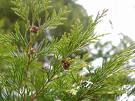Port Orford White cedar Tree Information
Images of Port Orford White cedar:






Port Orford White cedar grows in the following 3 states and provinces:
California, Hawaii, OregonInformation about Port Orford White cedar:
The Chamaecyparis Lawsoniana is commonly known as the False Cypress, Ginger Pine, Lawson Cypress, Lawson False-cypress, Oregon-cedar, Port Orford-cedar, Port-Orford White-cedar, Port-Orford-cedar as well as White Cedar.
The currently accepted scientific name of Port-Orford-cedar is Chamaecyparis lawsoniana (A. Murr.) Parl. . There are no recognized subspecies, varieties, or forms; however, over 200 cultivars have been developed which vary in size, shape, branching, and coloration . Port-Orford-cedar belongs to the family Cupressaceae. The genus Chamaecyparis includes eight taxa of which Port-Orford-cedar is the largest in size. The range of Alaska-cedar (Chamaecyparis nootkatensis) overlaps that of Port-Orford-cedar, but natural hybrids are extremely rare .Port-Orford-cedar has a very limited distribution, occurring near the Pacific Ocean in southwestern Oregon and northwestern California. The northern limit of its distribution is near Coos Bay, Oregon. The species' range extends southward about 220 miles (350 km) to the central portion of the Mad River drainage in Humbolt County, California . Isolated populations occur near Mount Shasta and the Trinity Mountains in northern California . It occurs in greatest abundance within about 40 miles of the coast . Farther inland, its distribution is spotty, and it is mostly limited to sites with abundant soil moisture and/or atmospheric moisture . Port-Orford-cedar is cultivated in Hawaii .Port-Orford-cedar is found in many vegetation types where it either forms small, pure stands, codominates with other conifers, or occurs as scattered trees. It is a long-lived, shade-tolerant climax species that dominates or codominates with other coniferous trees to form mature stands within four vegetation zones. The following published classification schemes list Port-Orford-cedar as a climax species or dominant part of the vegetation in community types (cts) or plant associations (pas) within the Sitka spruce (Picea sitchensis), white fir (Abies concolor), western hemlock (Tsuga heterophylla), and mixed-evergreen zones: Area Classification Authority CA, OR: Siskiyou Mtns general veg. pas Atzet & Wheeler 1984 OR: Upper Illinois general veg. cts Atzet 1979 River drainage CA, OR Port-Orford-cedar cts Hawk 1977 OR, WA general veg. cts Franklin & Dyrness 1973 Some of the information provided here is attributed to:Uchytil, Ronald J. 1990. Chamaecyparis lawsoniana. In: Fire Effects Information System, [Online]. U.S. Department of Agriculture, Forest Service, Rocky Mountain Research Station, Fire Sciences Laboratory (Producer). , available at the USDA Fire Effects Information System (FEIS) website